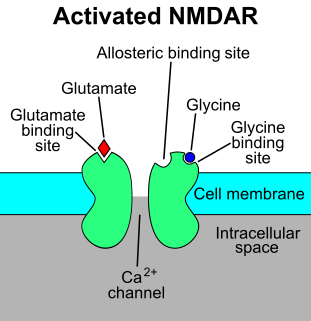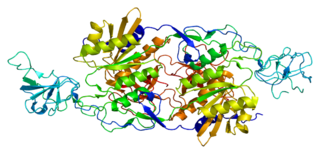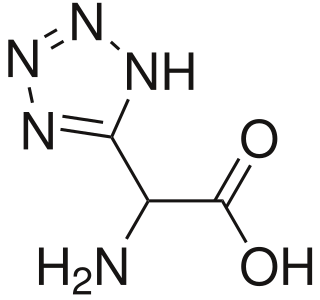Related Research Articles
Serine is an ɑ-amino acid that is used in the biosynthesis of proteins. It contains an α-amino group, a carboxyl group, and a side chain consisting of a hydroxymethyl group, classifying it as a polar amino acid. It can be synthesized in the human body under normal physiological circumstances, making it a nonessential amino acid. It is encoded by the codons UCU, UCC, UCA, UCG, AGU and AGC.

The N-methyl-D-aspartatereceptor, is a glutamate receptor and ion channel protein found in nerve cells. The NMDA receptor is one of three types of ionotropic glutamate receptors. The other receptors are the AMPA and kainate receptors. It is activated when glutamate and glycine bind to it, and when activated it allows positively charged ions to flow through the cell membrane. The NMDA receptor is very important for controlling synaptic plasticity and memory function.

5,7-Dichlorokynurenic acid (DCKA) is a selective NMDA receptor antagonist acting at the glycine site of the NMDA receptor complex.

Glycine receptor subunit alpha-1 is a protein that in humans is encoded by the GLRA1 gene.

Glycine receptor subunit beta is a protein that in humans is encoded by the GLRB gene.

Glycine receptor subunit alpha-2 is a protein that in humans is encoded by the GLRA2 gene.

The glycine receptor, alpha 4, also known as GLRA4, is a human pseudogene. The protein encoded by this gene is a subunit of the glycine receptor.

Tetrazolylglycine is a potent and selective NMDA receptor agonist, stimulating the NMDA receptor with higher potency than either glutamate or NMDA. It is a potent convulsant and excitotoxin and is used in scientific research.

Tutin is a poisonous plant derivative found in New Zealand tutu plants. It acts as a potent antagonist of the glycine receptor, and has powerful convulsant effects. It is used in scientific research into the glycine receptor. It is sometimes associated with outbreaks of toxic honey poisoning when bees feed on honeydew exudate from the sap-sucking passionvine hopper insect, when the vine hoppers have been feeding on the sap of tutu bushes. Toxic honey is a rare event and is more likely to occur when comb honey is eaten directly from a hive that has been harvesting honeydew from passionvine hoppers feeding on tutu plants.

Pitrazepin is a competitive GABAA and glycine receptor antagonist. It has been used to study insect and snail nervous systems in scientific research.

PCCG-4 is a research drug which acts as a selective antagonist for the group II metabotropic glutamate receptors (mGluR2/3), with slight selectivity for mGluR2 although not sufficient to distinguish mGluR2 and mGluR3 responses from each other. It is used in research into the function of the group II metabotropic glutamate receptors.

Gavestinel (GV-150,526) was an investigational drug developed by GlaxoSmithKline for acute intracerebral hemorrhage, which in 2001 failed to show an effect in what was at the time, the largest clinical trial in stroke that had been conducted.

Quisqualamine is the α-decarboxylated analogue of quisqualic acid, as well as a relative of the neurotransmitters glutamate and γ-aminobutyric acid (GABA). α-Decarboxylation of excitatory amino acids can produce derivatives with inhibitory effects. Indeed, unlike quisqualic acid, quisqualamine has central depressant and neuroprotective properties and appears to act predominantly as an agonist of the GABAA receptor and also to a lesser extent as an agonist of the glycine receptor, due to the facts that its actions are inhibited in vitro by GABAA antagonists like bicuculline and picrotoxin and by the glycine antagonist strychnine, respectively. Mg2+ and DL-AP5, NMDA receptor blockers, CNQX, an antagonist of both the AMPA and kainate receptors, and 2-hydroxysaclofen, a GABAB receptor antagonist, do not affect quisqualamine's actions in vitro, suggesting that it does not directly affect the ionotropic glutamate receptors or the GABAB receptor in any way. Whether it binds to and acts upon any of the metabotropic glutamate receptors like its analogue quisqualic acid however is unclear.

N-Arachidonylglycine (NAGly) is a carboxylic metabolite of the endocannabinoid anandamide (AEA). Since it was first synthesized in 1996, NAGly has been a primary focus of the relatively contemporary field of lipidomics due to its wide range of signaling targets in the brain, the immune system and throughout various other bodily systems. In combination with 2‐arachidonoyl glycerol (2‐AG), NAGly has enabled the identification of a family of lipids often referred to as endocannabinoids. Recently, NAGly has been found to bind to G-protein coupled receptor 18 (GPR18), the putative abnormal cannabidiol receptor. NaGly is an endogenous inhibitor of fatty acid amide hydrolase (FAAH) and thereby increases the ethanolamide endocannabinoids AEA, oleoylethanolamide (OEA) and palmitoylethanolamide (PEA) levels. NaGly is found throughout the body and research on its explicit functions is ongoing.

HA-966 or (±) 3-Amino-1-hydroxy-pyrrolidin-2-one is a molecule used in scientific research as a glycine receptor and NMDA receptor antagonist / low efficacy partial agonist. It has neuroprotective and anticonvulsant, anxiolytic, antinociceptive and sedative / hypnotic effects in animal models. Pilot human clinical trials in the early 1960s showed that HA-966 appeared to benefit patients with tremors of extrapyramidal origin.

Bitopertin is a glycine reuptake inhibitor which was under development by Roche as an adjunct to antipsychotics for the treatment of persistent negative symptoms or suboptimally-controlled positive symptoms associated with schizophrenia. Research into this indication has been largely halted as a result of disappointing trial results, but Roche continues to develop bitopertin for the treatment of obsessive-compulsive disorder (OCD).

Rapastinel (INN) (former developmental code names GLYX-13, BV-102) is a novel antidepressant that is under development by Allergan (previously Naurex) as an adjunctive therapy for the treatment of treatment-resistant major depressive disorder. It is a centrally active, intravenously administered (non-orally active) amidated tetrapeptide (Thr-Pro-Pro-Thr-NH2) that acts as a selective, weak partial agonist (mixed antagonist/agonist) of an allosteric site of the glycine site of the NMDA receptor complex (Emax ≈ 25%). The drug is a rapid-acting and long-lasting antidepressant as well as robust cognitive enhancer by virtue of its ability to both inhibit and enhance NMDA receptor-mediated signal transduction.

BIIB-104, also known as PF-04958242 is a positive allosteric modulator (PAM) of the AMPA receptor (AMPAR), an ionotropic glutamate receptor, which is under development by Pfizer for the treatment of cognitive symptoms in schizophrenia. It was also under development for the treatment of age-related sensorineural hearing loss, but development for this indication was terminated due to insufficient effectiveness. As of July 2018, BIIB-104 is in phase II clinical trials for cognitive symptoms in schizophrenia.
References
| This drug article relating to the nervous system is a stub. You can help Wikipedia by expanding it. |